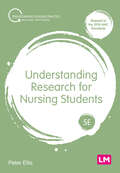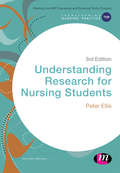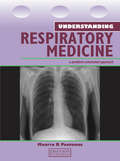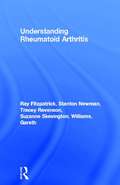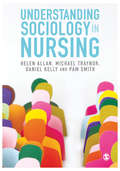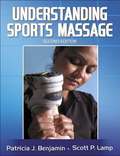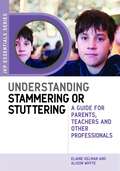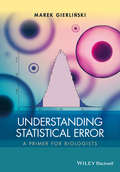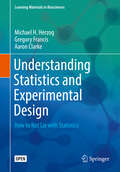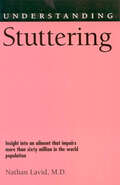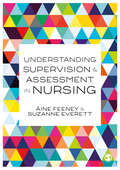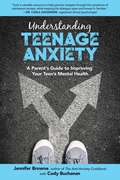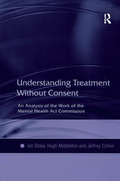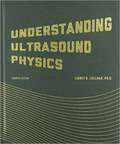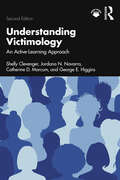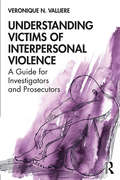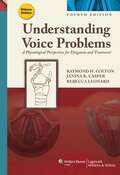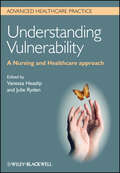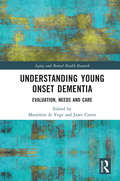- Table View
- List View
Understanding Research for Nursing Students (Transforming Nursing Practice Series)
by Peter EllisGet to grips with all aspects of research that you need to succeed in your nursing degree. Learn why research is so important to nursing, develop your knowledge of key methods and terminology and build your confidence in applying research principles to your nursing practice. Key features o Each chapter is mapped to the 2018 NMC standards, showing how research relates to the requirements of a registered nurse o Straightforward language and a step-by-step approach introduce you to key concepts and guide you through all aspects of the research process o Filled with activities and case studies to help you apply research principles and methods to your studies and practice
Understanding Research for Nursing Students (Transforming Nursing Practice Series)
by Peter EllisGet to grips with all aspects of research that you need to succeed in your nursing degree. Learn why research is so important to nursing, develop your knowledge of key methods and terminology and build your confidence in applying research principles to your nursing practice. Key features o Each chapter is mapped to the 2018 NMC standards, showing how research relates to the requirements of a registered nurse o Straightforward language and a step-by-step approach introduce you to key concepts and guide you through all aspects of the research process o Filled with activities and case studies to help you apply research principles and methods to your studies and practice
Understanding Research for Nursing Students (Transforming Nursing Practice Series)
by Peter EllisGet to grips with all aspects of research that you need to succeed in your nursing degree. Learn why research is so important to nursing, develop your knowledge of key methods and terminology and build your confidence in applying research principles to your nursing practice. Key features • Each chapter is mapped to the 2018 NMC standards, showing how research relates to the requirements of a registered nurse • Includes new case studies drawn from real life research and expanded discussions of research ethics and participant support • Uses straightforward language and a step-by-step approach to introduce you to key concepts and guide you through all aspects of the research process • Filled with activities and case studies to help you apply research principles and methods to your studies and real-world practice
Understanding Research for Nursing Students (Transforming Nursing Practice Series)
by Peter EllisGet to grips with all aspects of research that you need to succeed in your nursing degree. Learn why research is so important to nursing, develop your knowledge of key methods and terminology and build your confidence in applying research principles to your nursing practice. Key features • Each chapter is mapped to the 2018 NMC standards, showing how research relates to the requirements of a registered nurse • Includes new case studies drawn from real life research and expanded discussions of research ethics and participant support • Uses straightforward language and a step-by-step approach to introduce you to key concepts and guide you through all aspects of the research process • Filled with activities and case studies to help you apply research principles and methods to your studies and real-world practice
Understanding Research for Nursing Students (Transforming Nursing Practice)
by Peter EllisFrom the start of their training it's crucial for nursing students to be able to understand and evaluate current research to support their learning and reading for assignments. However, many books focus on how to do research, rather than how to understand and evaluate research. This book helps students recognise what good research is by providing an entry level guide to the main research methodologies used in nursing. It puts research into context for student nurses, explaining how they need to use the skills of critiquing and evaluating research throughout their course and how this is linked to evidence-based practice.
Understanding Respiratory Medicine: A Problem-Oriented Approach (Medical Understanding Series)
by Martyn PartridgeIn this concise practical guide the Editor and Authors combine a symptoms- and problem-based approach with systematic coverage of lung disease - to help students and young professionals to understand respiratory medicine in the round.The first section of the book is devoted to the underlying principles and clinical skills needed - science and disea
Understanding Rheumatoid Arthritis
by Gareth Williams Ray Fitzpatrick Stanton Newman Tracey Revenson Suzanne SkevingtonRheumatoid arthritis (RA) is a major cause of disability affecting about 1% of the population. Although much effort has been expended on research into the causes and cures of RA, little progress has been made. The focus of treatment in RA is on reducing the disabling consequences of the disease and controlling the symptoms. Understanding Rheumatoid Arthritis examines the nature of RA and its symptoms of pain and stiffness. The role of health care professionals and the individual's encounters with the doctor are important to understand as these experiences influence the individual's behaviour and understanding of their RA. This book will be an invaluable aid to the considerable number of people who suffer from rheumatoid arthritis, their families, carers and all health professionals involved in its treatment.
Understanding Sociology in Nursing
by Daniel Kelly Pam Smith Michael Traynor Helen AllanProvides students with insights into key contemporary debates and events to demonstrate the relevance of sociology and its practical application to modern nursing. This textbook helps student nurses make the leap from a narrow focus on the physical problems of their patients to a broader understanding of the whole person and the contexts of care which will help them succeed as compassionate nurses. Written directly for nurses, it focuses on the individuals and families in their care, the organisations they work in, and the factors which affect their practice. Key features include: Case studies and scenarios to help students relate sociology to real-life examples Reflection points to help students critically engage with the discussion Learning outcomes and chapter summaries for revision Definitions of key terms in each chapter
Understanding Sociology in Nursing
by Daniel Kelly Pam Smith Michael Traynor Helen AllanProvides students with insights into key contemporary debates and events to demonstrate the relevance of sociology and its practical application to modern nursing. This textbook helps student nurses make the leap from a narrow focus on the physical problems of their patients to a broader understanding of the whole person and the contexts of care which will help them succeed as compassionate nurses. Written directly for nurses, it focuses on the individuals and families in their care, the organisations they work in, and the factors which affect their practice. Key features include: Case studies and scenarios to help students relate sociology to real-life examples Reflection points to help students critically engage with the discussion Learning outcomes and chapter summaries for revision Definitions of key terms in each chapter
Understanding Sports Massage (2nd edition)
by Patricia J. Benjamin Scott P. LampUnderstanding Sports Massage is ideal for sport professionals and students in training programs. The book explains massage techniques in detail and describes the procedures involved in conducting effective sports massage sessions.
Understanding Stammering or Stuttering: A Guide for Parents, Teachers and Other Professionals
by Michael Palin Alison Whyte Elaine KelmanParents and teachers of children who stammer (or stutter) may see their child suffering with embarrassment, frustration or anxiety but feel at a loss as to how best to help. This book explains the characteristics of stammering and uses illuminating first-hand accounts to demonstrate the common feelings of anguish experienced and provide clarity on what the child is likely to need in terms of support at home, school and in social situations. Packed with helpful advice for carers about how to build a child's confidence, it presents a variety of techniques and tips to alleviate the stammer and improve self-esteem and school performance. This accessible resource will shed light on the perplexing nature of stammers, enabling those who care for children affected to find answers and get the best possible help.
Understanding Statistical Error
by Marek GierlinskiThis accessible introductory textbook provides a straightforward, practical explanation of how statistical analysis and error measurements should be applied in biological research. Understanding Statistical Error - A Primer for Biologists: Introduces the essential topic of error analysis to biologists Contains mathematics at a level that all biologists can grasp Presents the formulas required to calculate each confidence interval for use in practice Is based on a successful series of lectures from the author's established course Assuming no prior knowledge of statistics, this book covers the central topics needed for efficient data analysis, ranging from probability distributions, statistical estimators, confidence intervals, error propagation and uncertainties in linear regression, to advice on how to use error bars in graphs properly. Using simple mathematics, all these topics are carefully explained and illustrated with figures and worked examples. The emphasis throughout is on visual representation and on helping the reader to approach the analysis of experimental data with confidence. This useful guide explains how to evaluate uncertainties of key parameters, such as the mean, median, proportion and correlation coefficient. Crucially, the reader will also learn why confidence intervals are important and how they compare against other measures of uncertainty. Understanding Statistical Error - A Primer for Biologists can be used both by students and researchers to deepen their knowledge and find practical formulae to carry out error analysis calculations. It is a valuable guide for students, experimental biologists and professional researchers in biology, biostatistics, computational biology, cell and molecular biology, ecology, biological chemistry, drug discovery, biophysics, as well as wider subjects within life sciences and any field where error analysis is required.
Understanding Statistics and Experimental Design: How to Not Lie with Statistics (Learning Materials in Biosciences)
by Gregory Francis Michael H. Herzog Aaron ClarkeThis open access textbook provides the background needed to correctly use, interpret and understand statistics and statistical data in diverse settings. Part I makes key concepts in statistics readily clear. Parts I and II give an overview of the most common tests (t-test, ANOVA, correlations) and work out their statistical principles. Part III provides insight into meta-statistics (statistics of statistics) and demonstrates why experiments often do not replicate. Finally, the textbook shows how complex statistics can be avoided by using clever experimental design. Both non-scientists and students in Biology, Biomedicine and Engineering will benefit from the book by learning the statistical basis of scientific claims and by discovering ways to evaluate the quality of scientific reports in academic journals and news outlets.
Understanding Stuttering (Understanding Health and Sickness Series)
by Nathan Lavid M.D.Stuttering is an affliction that affects every ethnicity and every culture equally, some sixty million people worldwide. Five percent of children stutter. Typically, this debilitating condition emerges when a child is between the ages of two and six. Twenty percent of these children will continue to stutter as adults. Although it is so pervasive, there is great misunderstanding about stuttering. Socially isolating the people it strikes, the disorder prevents them from the kind of candid discussions that would help them gain an understanding of it. In turn, social isolation creates misconceptions. In Understanding Stuttering a writer, who is both a practicing physician and former researcher on stuttering, examines the medical roots of the problem and, hoping to bring alleviation, shares his findings. He defines stuttering as a medical condition that is neurologically based or inherited. In clear language he explains the basics of brain anatomy and function, tells of the latest scientific advances in diagnosis and treatment of stuttering, and explains the difference in acquired stuttering and Tourette syndrome. Using examples from his practice, he details effective treatments, including speech therapy and medications. He discusses the most promising new research and tells how the findings of this research will improve treatments and provide a possible cure. Understanding Stuttering concludes with practical tips on how to converse with those who stutter and lists organizations that provide additional information and support.
Understanding Supervision and Assessment in Nursing
by Áine Feeney Su EverettA practical guide for registered nurses in all fields, who are planning to undertake one of the new supervisor or assessor roles outlined in the latest NMC standards. The book helps nurses prepare for the role of practice supervisor, practice assessor or academic assessor, by outlining what is expected in each of the roles, in accordance with the 2018 NMC standards, and explaining which competencies are needed to ensure success in the new supervisory and academic positions. These competencies include: · Understanding how students learn · Understanding how to empower nurses and why this is important · Learning to utilise student feedback to enhance your own development · Identifying the importance of including the participation of service users in nursing governance and quality · Ensuring compliance with all legal, regulatory, professional and educational requirements. It will also be useful for experienced NMC mentors and practitioners looking to update their skills for the new NMC Educational Framework.
Understanding Supervision and Assessment in Nursing
by Áine Feeney Su EverettA practical guide for registered nurses in all fields, who are planning to undertake one of the new supervisor or assessor roles outlined in the latest NMC standards. The book helps nurses prepare for the role of practice supervisor, practice assessor or academic assessor, by outlining what is expected in each of the roles, in accordance with the 2018 NMC standards, and explaining which competencies are needed to ensure success in the new supervisory and academic positions. These competencies include: · Understanding how students learn · Understanding how to empower nurses and why this is important · Learning to utilise student feedback to enhance your own development · Identifying the importance of including the participation of service users in nursing governance and quality · Ensuring compliance with all legal, regulatory, professional and educational requirements. It will also be useful for experienced NMC mentors and practitioners looking to update their skills for the new NMC Educational Framework.
Understanding Teenage Anxiety: A Parent's Guide to Improving Your Teen's Mental Health
by Jennifer Browne Cody BuchananIf you’re the parent of a teenager experiencing chronic anxiety, this book is for you.Today’s teens are high-strung and socially overextended. We shrug it off as a millennial problem, but is it? In a world that encourages the quick fix, instant gratification, and real-time feedback, can we really expect our children to cope as we did less than two decades ago, in the land of handshakes, eye contact, elbow grease, and grit?This book is a product of a combination of three very different perspectives: those of the anxious teen, the parent, and the therapist. We need to understand what we’ve created in terms of our current society to gain proper insight on why we’re seeing increasingly rising levels of anxiety in our teenagers. Topics include:Physical and Emotional Symptoms of AnxietyTeens and Self-HarmAnxiety and Gut HealthSports: Concussions and AnxietyNatural Ways to Help Your Teen CopeAnd much, much moreWithin each chapter, author (and parent) Jennifer Browne and co-author (Jennifer’s teenage son) Cody Buchanan, who struggles with anxiety and depression, will weigh in on what this affliction feels like, physically, mentally, and emotionally. They share personal experiences to help parents better understand their teens and learn a lot along the way.
Understanding Treatment Without Consent: An Analysis of the Work of the Mental Health Act Commission
by Ian Shaw Hugh MiddletonIn Understanding Treatment Without Consent, key contributors examine the work of the UK Mental Health Act Commission (MHAC), which was established to ensure the care and rights of people subjected to the various sections of the 1983 Mental Health Act. Based on a research project funded by the Department of Health, the book also offers a broader exploration of mental health provision in both historical and contemporary contexts, discussing whether mental health reforms have learned the lessons of history. The book builds on earlier work on treatment without consent by providing a more policy-oriented account of mental health law and regulation in the context of health service modernization, discussing contemporary issues facing the MHAC and looking at its future role.
Understanding Treatment of Mild Traumatic Brain Injury in the Military Health System
by Carrie M. Farmer Heather Krull Thomas W. Concannon Kimberly A. Hepner Teague Ruder Andrew M. Parker Benjamin Batorsky Francesca Pillemer Liisa Hiatt Maulik P. Purohit Molly SimmonsA RAND study, the first to examine care received by a census of active-duty service members diagnosed with mild traumatic brain injury in the Military Health System, assessed the number and characteristics of these patients (including deployment history and history of traumatic brain injury), their care settings, the treatments they received, co-occurring conditions, the duration of treatment, and the risk factors for requiring long-term care.
Understanding Ultrasound Physics
by Sidney K. EdelmanWe continue to innovate in the arena of physics exam preparation. In this 4th edition, we have added chapters describing optimization of Doppler imaging and sonographers in the clinical setting. We have added many topics such as patient communication, medical ethics, informed consent, ergonomics, elastography, and standard precautions that should be taken as part of the educational and exam preparation processes. We have expanded the information provided on quality assurance, bioeffects, displays, and imaging processing, and restructured much of how we present basic physics information, including axial and lateral resolution.
Understanding Victimology: An Active-Learning Approach
by George E. Higgins Catherine D. Marcum Shelly Clevenger Jordana N. NavarroUnderstanding Victimology: An Active Learning Approach is the only textbook with extensive discussion of both online and offline victimization reinforced by group and individual learning activities. Our textbook offers instructors a variety of active learning exercises – in the book itself and in the authors’ ancillaries – that engage students in the material and shed light on the experiences of marginalized social groups. Through these activities, students become engaged with the material at a higher level of learning. They learn how victimization happens and the challenges people who experience crime face in acquiring assistance from the criminal-legal system at a more intimate level instead of simply reading about it. Students also build their abilities to work with others in a collaborative learning environment, encouraging professional socialization for the future. The chapters in this second edition address gaps in information typically presented in victimology that ignore prevention or intervention, even though these topics are currently at the forefront of the national conversation going on about sexual violence in higher education. New to this edition are added coverage of immigrants and minorities and new chapters on the media and victimization and on victimization across the gender spectrum, as well as an online instructor resource covering UK case studies, legal framework, and social context that broadens the book’s global appeal. Suitable for undergraduate courses in victimology, this book also serves the needs of sociology and women’s studies courses and can be taught university-wide as part of diversity and inclusion initiatives.
Understanding Victims of Interpersonal Violence: A Guide for Investigators and Prosecutors
by Veronique N. ValliereUnderstanding Victims of Interpersonal Violence: A Guide for Investigators and Prosecutors provides accessible information for criminal justice personnel "in the trenches" with victims of violence to aid in understanding and explaining their behavior. This guide sheds light on interpersonal violence victims’ decisions and actions by providing context and naming factors that commonly impact victim responses. These include internal factors such as culture, religion, shame, and personality, as well as external factors like access to services, support systems, and resources. These factors inhibit or facilitate responses like disclosure, resistance, and participation (or lack thereof) in the prosecution of the offenders. This book also explores the influence of the perpetrator, as well as more deeply examining victim responses that typically offer challenges to investigators and prosecutors; for example, continued contact with the offender, lack of resistance, and issues in disclosure. Finally, the guide provides concrete tools to assist investigators in interviewing and for prosecutors to use during the prosecutorial process. This book is designed for investigators, prosecutors, advocates, criminal justice practitioners, and students of these subjects.
Understanding Voice Problems: A Physiological Perspective For Diagnosis And Treatment
by Raymond H. Colton Janina K. Casper Rebecca LeonardUnderstanding Voice Problems: A Physiological Perspective for Diagnosis and Treatment emphasizes the physiological perspective of voice disorders—and the behavioral and emotional factors that can influence these changes. Readers will find a strong foundation in normal phonatory physiology and acoustics as well as pathophysiology arising from voice misuse, abuse, or neurological involvement. Coverage includes in-depth explorations of patient interviewing, history-taking, examination, and testing and discussions of pediatric and geriatric voice considerations. The book contains numerous illustrations, including full-color plates of vocal fold pathologies. A companion website features over 20 videos that demonstrate healthy, normally functioning larynges at work, plus larynges with various pathological problems.
Understanding Vulnerability
by Julie Ryden Vanessa HeaslipThe notion of vulnerability is critical to person-centred and high-quality nursing and healthcare practice, and underpins all nursing education. Understanding Vulnerability: a Nursing and Healthcare Approach focuses on vulnerability experienced every day by patients and clients in healthcare, and provides clear and supportive guidance to nurses and other healthcare practitioners on protecting and caring for vulnerable patients. Taking a fresh, critical and reflective perspective that reflects current trends towards the promotion of equality and acknowledges everyone's vulnerability, this book is essential reading for all nursing and healthcare students, as well as healthcare practitioners who are committed to providing person-centred care. Special features: *One of the first books to address the issue of vulnerability from a nursing and healthcare perspective *Written by a group of experienced professionals, academics and educationalists with both educational and research expertise in the exploration of vulnerability *Includes narratives, perspectives and case studies, illustrating and bringing to life the issues within the book
Understanding Young Onset Dementia: Evaluation, Needs and Care (Aging and Mental Health Research)
by Marjolein De VugtUnderstanding Young Onset Dementia provides a state-of-the-art overview of approaches to care and evaluation for people with young onset dementia. It reviews the challenges in providing care and services, outlines new innovations in treatment and explores the impact of the condition to offer guidance about best practice in care. Written by world-leading researchers and experts in the field, this book gives key evidence for best practice and focuses on lived experience of those with young onset dementia. It has a broad focus looking at aspects of care beyond diagnosis and gives a comprehensive summary of the current qualitative and quantitative research in the field of young onset dementia. This international collaboration fills a much-needed gap in the academic market and is vital to guide learning and deliver future innovations. This book will be of great interest for academics, scholars and post graduate students in the field of mental health and dementia research. It will also appeal to neurologists, psychiatrist, geriatricians and psychologists looking to update their knowledge or already working in the field.
